
The Enigma machine is an encryption device developed and used in the early- to mid-20th century to protect commercial, diplomatic and military communication. It was employed extensively by Nazi Germany during World War II, in all branches of the German military.

In the history of cryptography, Typex machines were British cipher machines used from 1937. It was an adaptation of the commercial German Enigma with a number of enhancements that greatly increased its security. The cipher machine was used until the mid-1950s when other more modern military encryption systems came into use.
In the history of cryptography, the ECM Mark II was a cipher machine used by the United States for message encryption from World War II until the 1950s. The machine was also known as the SIGABA or Converter M-134 by the Army, or CSP-888/889 by the Navy, and a modified Navy version was termed the CSP-2900.
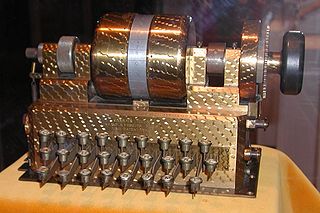
The Hebern Rotor Machine was an electro-mechanical encryption machine built by combining the mechanical parts of a standard typewriter with the electrical parts of an electric typewriter, connecting the two through a scrambler. It is the first example of a class of machines known as rotor machines that would become the primary form of encryption during World War II and for some time after, and which included such famous examples as the German Enigma.
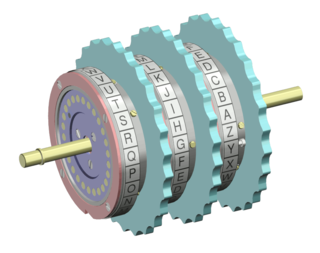
In cryptography, a rotor machine is an electro-mechanical stream cipher device used for encrypting and decrypting secret messages. Rotor machines were the cryptographic state-of-the-art for a prominent period of history; they were in widespread use in the 1920s–1970s. The most famous example is the German Enigma machine, whose messages were deciphered by the Allies during World War II, producing intelligence code-named Ultra.

The bombe is an electro-mechanical device used by the British cryptologists to help decipher German Enigma-machine-encrypted secret messages during World War II. The US Navy and US Army later produced their own machines to the same functional specification, albeit engineered differently both from each other and from Polish and British Bombes.
The bomba, or bomba kryptologiczna, was a special-purpose machine designed about October 1938 by Polish Cipher Bureau cryptologist Marian Rejewski to break German Enigma-machine ciphers.

The M-94 was a piece of cryptographic equipment used by the United States army, consisting of several lettered discs arranged as a cylinder. It was also employed by the US Navy, under the name CSP 488.
Cryptanalysis of the Enigma ciphering system enabled the western Allies in World War II to read substantial amounts of Morse-coded radio communications of the Axis powers that had been enciphered using Enigma machines. This yielded military intelligence which, along with that from other decrypted Axis radio and teleprinter transmissions, was given the codename Ultra. This was considered by western Supreme Allied Commander Dwight D. Eisenhower to have been "decisive" to the Allied victory.

The method of Zygalski sheets was a cryptologic technique used by the Polish Cipher Bureau before and during World War II, and during the war also by British cryptologists at Bletchley Park, to decrypt messages enciphered on German Enigma machines.
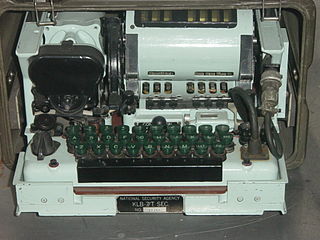
The TSEC/KL-7 was an off-line non-reciprocal rotor encryption machine. The KL-7 had rotors to encrypt the text, most of which moved in a complex pattern, controlled by notched rings. The non-moving rotor was in fourth from the left of the stack. The KL-7 with 12 rotors also encrypted the message indicator and was code named ADONIS.

In cryptography, Fialka (M-125) is the name of a Cold War-era Soviet cipher machine. A rotor machine, the device uses 10 rotors, each with 30 contacts along with mechanical pins to control stepping. It also makes use of a punched card mechanism. Fialka means "violet" in Russian. Information regarding the machine was quite scarce until c. 2005 because the device had been kept secret.
This article contains technical details about the rotors of the Enigma machine.
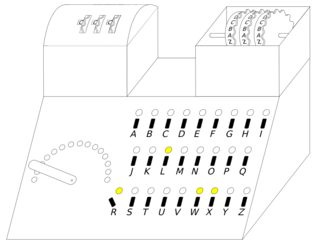
The cyclometer was a cryptologic device designed, "probably in 1934 or 1935," by Marian Rejewski of the Polish Cipher Bureau's German section (BS-4) to facilitate decryption of German Enigma ciphertext.
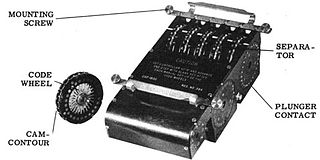
The Combined Cipher Machine (CCM) was a common cipher machine system for securing Allied communications during World War II and, for a few years after, by NATO. The British Typex machine and the US ECM Mark II were both modified so that they were interoperable.

SIGCUM, also known as Converter M-228, was a rotor cipher machine used to encrypt teleprinter traffic by the United States Army. Hastily designed by William Friedman and Frank Rowlett, the system was put into service in January 1943 before any rigorous analysis of its security had taken place. SIGCUM was subsequently discovered to be insecure by Rowlett, and was immediately withdrawn from service. The machine was redesigned to improve its security, reintroduced into service by April 1943, and remained in use until the 1960s.

Marian Adam Rejewski was a Polish mathematician and cryptologist who reconstructed the Nazi German military Enigma cipher machine sight-unseen in 1932. The cryptologic achievements of Rejewski and colleagues Jerzy Różycki and Henryk Zygalski enabled the British to begin reading German Enigma-encrypted messages at the start of World War II, seven years after Rejewski's original reconstruction of the machine. The intelligence that was gained by the British from Enigma decrypts formed part of what was code-named Ultra and contributed—perhaps decisively—to the defeat of Germany.
A Polish Enigma "double" was a machine produced by the Polish Cipher Bureau that replicated the German Enigma rotor cipher machine. The Enigma double was one result of Marian Rejewski's remarkable achievement of determining the wiring of the Enigma's rotors and reflectors.
Edward Fokczyński was one of the four directors of the AVA Radio Company, an electronics firm established in Warsaw, Poland, in 1929. AVA produced radio equipment for the Polish General Staff's Cipher Bureau, which was responsible for the radio communications of the General Staff's Intelligence Section.
The Schlüsselgerät 39 (SG-39) was an electrically operated rotor cipher machine, invented by the German Fritz Menzer during World War II. The device was the evolution of the Enigma rotors coupled with three Hagelin pin wheels to provide variable stepping of the rotors. All three wheels stepped once with each encipherment. Rotors stepped according to normal Enigma rules, except that an active pin at the reading station for a pin wheel prevented the coupled rotor from stepping. The cycle for a normal Enigma was 17,576 characters. When the Schlüsselgerät 39 was correctly configured, its cycle length was characters, which was more that 15,000 times longer than a standard Enigma. The Schlüsselgerät 39 was fully automatic, in that when a key was pressed, the plain and cipher letters were printed on separate paper tapes, divided into five-digit groups. The Schlüsselgerät 39 was abandoned by German forces in favour of the Schlüsselgerät 41.
















